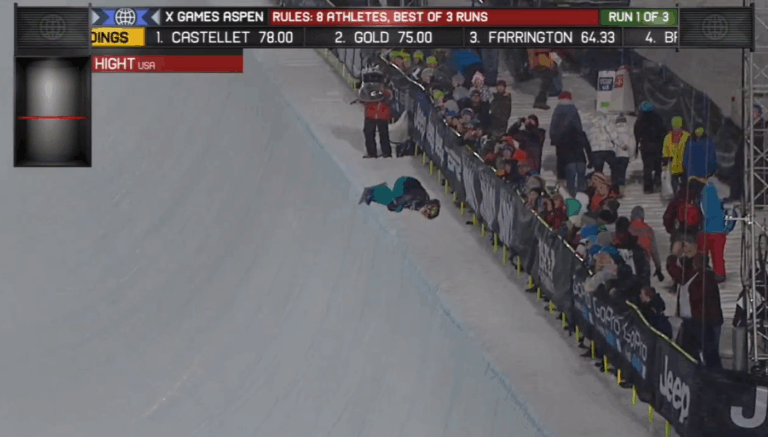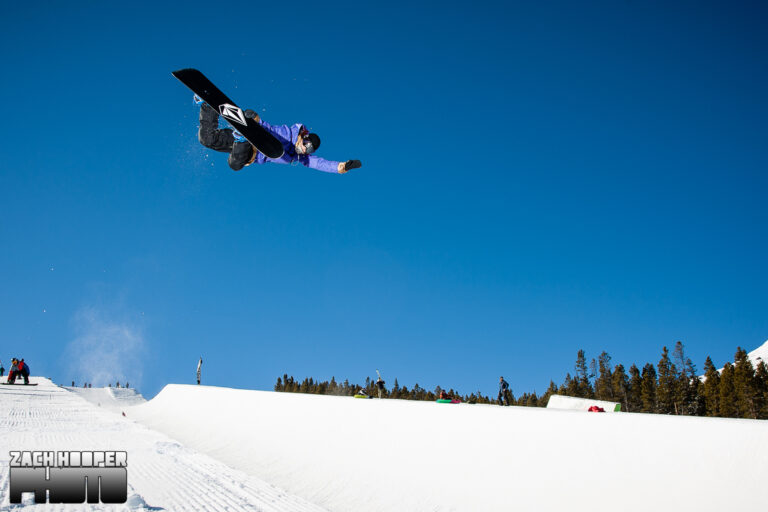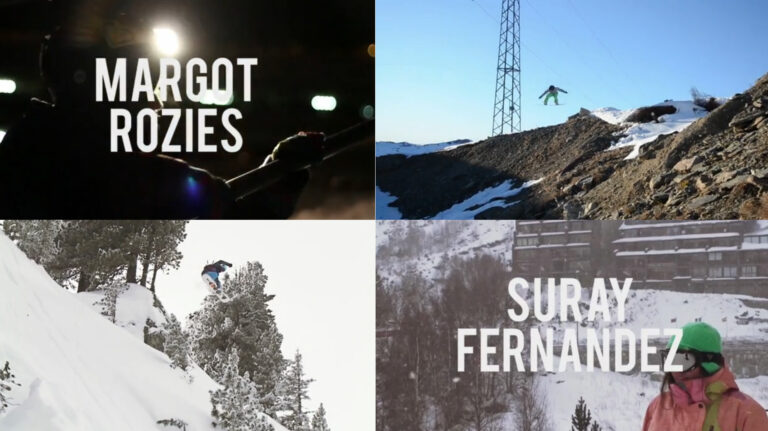
With the next Winter Olympics only a bit more than a year away, we found it time to give the whole slopestyle debate another look… Here’s our argument from the print mag last year – what’s your opinion? Leave a comment below and start discussing!
Words by Matt Barr, illustration by Eve Bracewell
Competition and action sports have long been uneasy bedfellows, well for ordinary riders, at least. Maybe there’s something intrinsically unwieldy about trying to graft a competitive framework onto an activity as free-spirited and free-flowing as snowboarding or surfing.
After all, these are supremely individual acts, the appeal of which is exactly that (as with Fight Club) there are no rules as in other sports. Success in a game of football or netball comes from your team putting a ball in a net more times than the other team. “Success” from a day’s snowboarding? That could be absolutely anything, from something as prosaic as picking the right goggles before you leave the house, to something as life-changing as truly stomping your first powder landing from a cliff that makes your mouth go dry before you drop in.
Still, the massive popularity of action sports (and the inherent competitiveness of human beings) meant that contests quickly became part of boardsports culture. In snowboarding, a 1983 contest held at Soda Springs, at which Tom Sims organised the first half pipe and Jake Burton reputedly tried to boycott it, has become part of the folklore of the sport.
Soon, the 80s pro scene was defined by contests, with the star riders like Craig Kelly and a young Terje Haakonsen making their name on the World Cup circuit that helped catalyse the sport’s massive growth during those neon-tinged salad days.
By the early 90s, Kelly’s decision to step away from the competitive arena and focus on filming helped shake up the pro side of sport along the lines we can broadly recognise today, where some pro shreds (such as Jake Blauvelt) film, some (like iPod [Iouri Podladtchikov]) seem to exclusively ride comps such as the TTR, and others (Travis Rice) do a bit of both.
So far, so straightforward. It’s a pattern that has also been mirrored to more or less the same extent in skating and surfing, and in all the sports has been largely ignored by riders for whom the issue has absolutely zero relevance to their own board-riding lives. But in snowboarding, half pipe and slalom’s inclusion in the 1998 and future Winter Olympics suddenly made this issue of competitions, and what they actually mean for the sport, one of real consequence.
Suddenly, snowboarding was thrust, blinking with uncertainty, onto the biggest sporting platform of all. Even more worryingly for shredding’s core custodians, the IOC decided to award control of the qualification process (and, hence, snowboarding’s future competitive development) to the ski federation FIS, an organisation that had so far had zero experience of organising snowboarding contests.
Why was this a big deal? Think of it like this. Imagine skateboarding suddenly gets fast-tracked into the Olympics. Then imagine a governing body that had nothing to do with the sport, say the cycling guys, suddenly decides they’re going to run things. Why not? They both have wheels, right?
Sounds crazy, right? Believe it or not, that discussion about skateboarding has actually been seriously suggested by some in the cycling community this year. And when snowboarding was made an Olympic sport back in the mid-90s, that’s pretty much exactly what happened, and snowboarders were not happy. Terje Haaksonen, by that stage the most famous pro on the planet, boycotted the Games in protest. Still, the show went on.
It’s this controversy that led directly to the establishment of the Ticket-to-Ride (TTR) tour, a series of events organised by the people that had been running shred events for years. Events like the US Open, and Air & Style. This coincided pretty much perfectly with rise of slopestyle snowboarding, a new competitive element of the sport based upon riders making the best runs through specially built snow parks. Slopestyle was part of the Roxy Chicken Jam, which launched in 2004, from the start. It was the first ever 6-star all-girls event.
For much of the decade, things settled down, albeit into a bizarre competitive situation that would see most top riders ride TTR events for three years out of four and complete ignore the FIS half pipe events. Until Olympic qualifying year that is, at which point everyone would then jump ship in an effort to qualify for the Olympics.
Such was the new status quo until the 2010 Olympics in Vancouver, and Shaun White’s gold medal-winning half pipe performance in front of a global audience. This was a seismic event for snowboarding (with American TV network recording one of its highest ratings of the year), illustrating as it did the rabid appetite there seemed to be for high level shred events. The result? Efforts to fast-track slopestyle snowboarding, which for mainstream TV has the potential to be an even sexier introduction to the sport, into the 2014 Winter Olympics began to move very quickly indeed.
Suddenly, snowboarding was again faced with the same situation. Still, a decade later, with the sport more organised, the TTR established and lessons learned, there was no way the same FIS debacle was going to happen again. Was there ….?
I think by now you can probably guess the answer to that one. At the time of writing, it does indeed seem as though the IOC are once again going to back FIS to organise the qualification process for the 2014 Winter Games.
The reasons why, involving TV production values, Byzantine inter-organisational politics and a few heavy accusations of corruption, are too complicated to go into here. But in essence we’re back at the same question that began this article. Why should ordinary snowboarders care?
After all it’s tough to find a pro who isn’t amped that slopestyle is in the Olympics, as Cooler cover star Sarka Pancochova stated. “I’m stoked about slopestyle being at the Olympics,” though she is also irked by the politics wishing that “the TTR could do the qualification. FIS events are always a shit show.”
From a British shredding perspective, the issue is a particularly delicate one because for once we have riders in Jenny Jones and Aimee Fuller, and in the men’s Jamie Nicholls, who actually have a chance of doing pretty well in slopestyle in 2014 (although whether they’ll all be able to qualify via the hoop-jumping qualification process FIS are proposing is another matter).
And as you might expect, the lure of an Olympic medal is strong. For Aimee Fuller, the Olympics are also an opportunity to showcase the sport to as many people as possible. As she said in her cover girl interview in the last issue, “Snowboarding isn’t a well known sport, especially in the UK, and it would really put it on the map if someone did well at the Olympics. It’s definitely a goal of mine but I’m not doing to let it affect anything that I’m doing right now”.
Jenny Jones is also keen, as she also told us in an interview last issue. “Erm I’d like to give it a crack. The biggest worry would be whether I’d be able to handle all that pressure and brush it off but then you’ve got to think of the best and worst case scenarios. And if in three years time I felt like my riding was still at a high enough standard compared to other riders, then I would like to give it a crack”.
It’s easy to see why the riders are concentrating on, well, the riding, rather than the politics. At its heart, this fascinating debate is nothing less than a battle for snowboarding’s soul. That might sound dramatic. But hell, it is dramatic. And confusing. We’re going for a lie down.





